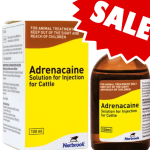Haemonchus contortus is a highly pathogenic, blood-feeding parasitic nematode that primarily infects the abomasum (true stomach) of sheep and goats. It is one of the most economically significant parasites in small ruminant farming due to its rapid reproduction, severe clinical effects, and growing resistance to anthelmintics. Over the past few weeks we have seen a steep rise in cases of this parasite, and if not caught early the effect can be deadly.
Life Cycle
The life cycle of Haemonchus includes both free-living and parasitic stages:
- Eggs are passed in the faeces of infected animals.
- Larvae (L1 to L3) develop in the environment, with L3 being the infective stage.
- Sheep ingest L3 larvae while grazing.
- Larvae migrate to the abomasum, mature into adults, and begin feeding on blood.
- Adult females can lay up to 5,000 eggs per day
This cycle can complete in as little as 21 days under warm, moist conditions, making outbreaks common in summer and autumn. With the spots of rain that we are seeing, this seems to be the perfect conditions for outbreaks to occur.
Clinical Signs
The severity of symptoms depends on the worm burden and the animal’s immune status. Common signs include:
- Severe anaemia (pale mucous membranes)
- Submandibular oedema (“bottle jaw”)
- Lethargy and weakness
- Weight loss and poor body condition
- Reduced milk production
- Sudden death, especially in lambs
Interestingly, diarrhoea is not a typical symptom, which helps differentiate haemonchosis from other gastrointestinal parasitic infections
Images of the Clinical Signs of Haemonchus




Diagnosis
- FAMACHA© scoring: Assesses anaemia by examining the colour of the lower eyelid.
- Faecal Egg Counts (FEC): Quantifies parasite burden and monitors treatment efficacy- please bring samples to the practice for a same day diagnosis and treatment plan. Early treatment is key here!
- Post-mortem examination: Reveals characteristic red-and-white striped worms in the abomasum .
Treatment
- Anthelmintics: Broad-spectrum dewormers (e.g., ivermectin, moxidectin) and narrow-spectrum drugs like closantel are commonly used. We stock a range of Yellow Group Wormers such as Levafas Diamond, Levacide LV and Chanaverm.
- Resistance management: Due to widespread drug resistance, it’s essential to rotate drug classes and use targeted selective treatment (TST) strategies
Prevention and Control
An integrated approach is key:
- Pasture Management:
- Rotate grazing areas.
- Avoid overstocking.
- Rest contaminated pastures.
- Selective Breeding:
- Cull animals with consistently high parasite burdens.
- Monitoring:
- Regular FEC and FAMACHA© checks.
- Body condition scoring.
- Quarantine Protocols:
- Treat and isolate new or returning animals before introducing them to the flock.
- Vaccination:
- Research into vaccines is ongoing. Promising candidates have shown partial protection, but no commercial vaccine is yet widely available .
Conclusion
Haemonchosis remains a major challenge in sheep production, particularly in warm and humid climates. With rising anthelmintic resistance, sustainable control requires a multifaceted strategy combining chemical, biological, and management tools. Early detection and proactive prevention are crucial to safeguarding flock health and farm profitability. Please contact us if you are concerned about your flock of 01746 713 911.





